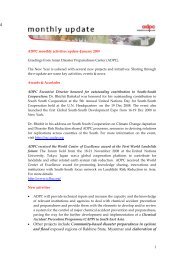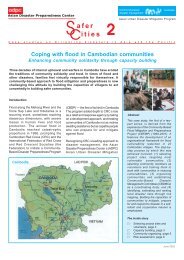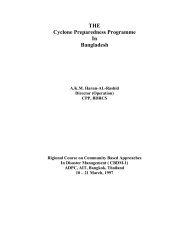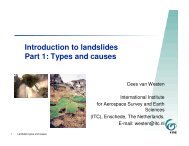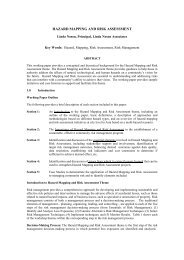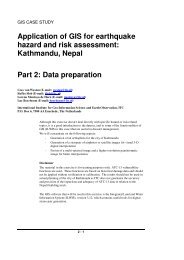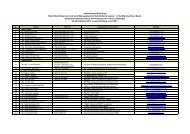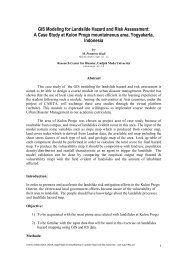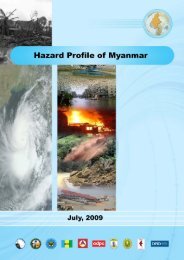community-based disaster risk management and the media media kit
community-based disaster risk management and the media media kit
community-based disaster risk management and the media media kit
You also want an ePaper? Increase the reach of your titles
YUMPU automatically turns print PDFs into web optimized ePapers that Google loves.
chapter 2. <strong>media</strong> <strong>and</strong> <strong>disaster</strong> <strong>risk</strong> <strong>management</strong><br />
causing distress <strong>and</strong> anxiety. The use of appropriate language is<br />
essential.<br />
Coverage of <strong>disaster</strong>s should be done with compassion <strong>and</strong> empathy,<br />
not adding to <strong>the</strong> distress of survivors, relatives <strong>and</strong> victims. People<br />
already in distress must not be put under pressure. Ethical practices<br />
must be adhered to, no matter what <strong>the</strong> circumstances may be.<br />
Following are some practical guidelines in ethical <strong>disaster</strong> reporting:<br />
• Show compassion for those who may be affected adversely by<br />
news coverage. Use special sensitivity when dealing with children<br />
<strong>and</strong> those grieving. The Dart Center for Journalism <strong>and</strong> Trauma in<br />
<strong>the</strong> US has guidelines on this point: “Children are more vulnerable<br />
to trauma because of <strong>the</strong>ir size, age <strong>and</strong> dependence. Prior trauma,<br />
past mental health problems or a family history of such problems<br />
may increase a child’s <strong>risk</strong>. Traumatized children may want to tell<br />
<strong>the</strong>ir story, but it may not be in <strong>the</strong>ir best interests to be interviewed,<br />
<strong>and</strong> in some circumstances it can exacerbate <strong>the</strong>ir exposure to<br />
trauma.”<br />
• Be sensitive when seeking or using interviews or photographs of<br />
those affected by tragedy or grief, as it may elicit traumatic memories<br />
<strong>and</strong> anxiety.<br />
• Recognize that ga<strong>the</strong>ring <strong>and</strong> reporting information may cause harm<br />
or discomfort. Pursuit of <strong>the</strong> news is not a license for arrogance.<br />
• Respect <strong>the</strong> work of emergency workers, relief <strong>and</strong> rescue squads,<br />
public safety agencies or o<strong>the</strong>r authorities especially during <strong>the</strong><br />
im<strong>media</strong>te onset of <strong>disaster</strong>. Do not press for information that may<br />
not be cleared for offi cial release yet.<br />
• Avoid reporting that may instill fear <strong>and</strong> panic. Ensure that stories<br />
presented will not offend public taste.<br />
• Be open <strong>and</strong> allow survivors to access <strong>the</strong> <strong>media</strong> to fi nd lost relatives<br />
or to make public service announcements.<br />
• Do not expose <strong>media</strong> crew or <strong>the</strong> public to danger (in cases of<br />
<strong>disaster</strong>) just to get a story.<br />
35



